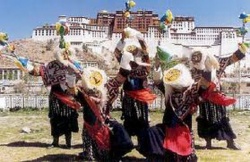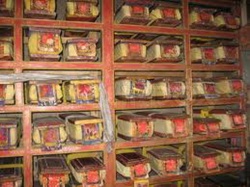The Tibetan Opera -LanSha WenPo
IN the Tibetan tradition, Langsha refers to an industrious and kind young woman.
The opera Langsha Wenpo is based on a story that is told among the Tibetan people.
The Goddess Kongxingmu sympathizes with an old couple Gongsang and his wife, both serfs who have no one to depend on.
She comes to them in the reincarnation of their daughter and is named Langsha Wenpo.
The arrival of Langsha brings great happiness to the old couple. At the age of 15, she is chosen by the powerful serf-owner Shanguan Chaxin, who forces her to marry his son Chaba Sangzhu.
After their marriage, Chaba begins to love Langsha. Chaba has an elder sister Ah Ni who, although a nun, still runs and manages the household. She sows dissension between Langsha and her husband and father-in-law and forced her to do back-night and often prodding the old man to beat her.
Chaba loves his wife deeply and is extremely angry at the cruelty his sister and father display. Ignoring his family rules, he goes to see his parents-in-law and is punished by his father for this. Langsha is moved by his action and gradually comes to love this son of a serf-owner.
A baby boy is born to them.
Ah Ni is terribly worried at the birth of Langsha's son and therefore treats her even more cruelly. The hardships of Langsha's life force her finally to flee to her own home. Chaxin and Ah Ni come chasing after her, wanting to burn her to death. Suddenly, Langsha turns into a goddess and flies up to Heaven amidst flames. The fire burns Chaxin and Ah Ni to death and the people, freed from evil, rejoice.
Tibetan opera is an ancient folk opera form using singing and dancing as its medium. It has the longest history among all the operas and plays of minority nationalities in China.
It dates back to the 8th century and falls into four categories: Buddhist stories, stories of historical personalities in Tibet, folk stories and stories of human relations with Langsha Wenpo as this last's most representative work. Many Tibetan operas describe the desires of the local people to win freedom and a bright future.
The best season of the year for seeing Tibetan operas is from the end of June to the beginning of July (according to the Tibetan calendar), during a festival which lasts for 10 days. Usually, performers from all corners of Tibet come to Lhasa and perform in Norbu-Linka, meaning the "Jewel Park".
In the past when the operas were performed for the when the operas were performed for the Dalai Lama, the female role was taken by male actors because Buddhist tradition has it that a female is considered inauspicious and it was deemed wrong for Dalai Lama to see one.
At that time, the Tibetan serfs were never able to enjoy the festival.
After Tibet was peacefully liberated in 1951, the feudal serf system was destroyed and the serfs stood up both politically and economically.
Now during such festivals, the citizens and herdsmen from Lhasa all dress up, and taking snacks and drinks along with them, go to the park to appreciate the operas. Sometimes the same opera is repeated several days running.
The People's Government of the Tibetan autonomous Region has appointed a research team to study Tibetan folk operas and plays.
The Opera Troupe of the Tibetan Autonomous Region was set up in 1960. Folk artists who used to wander from place to place were accepted into the troupe to teach the young artists, and the new-style Tibetan opera has been developed on the basis of the old tradition.
The troupe has its own make-up and costume staff, stage props and an orchestra.
Apart from the traditional operas they perform, the actors and actresses have also created a number of modern operas. Article by DU JIE

